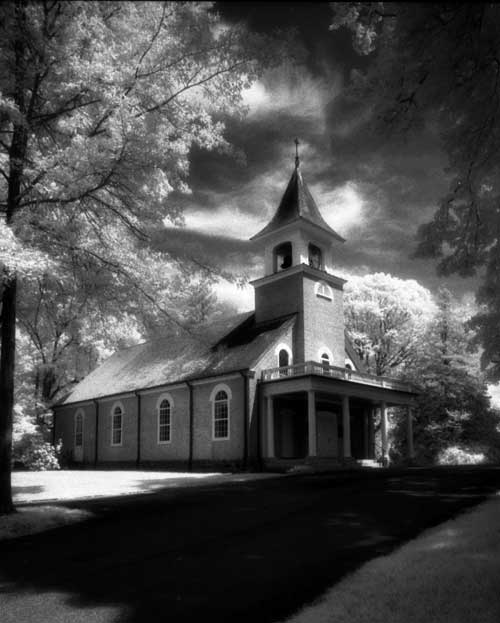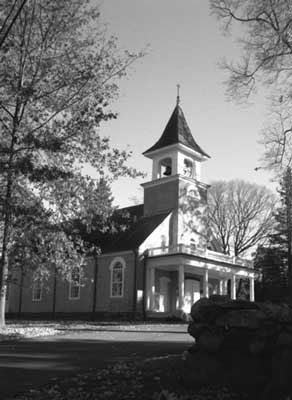 REGULAR
FILM
INFRARED FILM
REGULAR
FILM
INFRARED FILM

Mid
Day Landscape Blues?
Try
INFRARED BLACK & WHITE
By
Dennis DiBrizzi
I have always been drawn to country churches as primary elements for
much of
my landscape photography. Perhaps
it’s the quaint architecture that is found in
many of these old historic villages that dot the landscape of
Westchester
County
where I live. Then again, it may
be the combination of the building set amongst
spacious grounds, surrounded by old, towering , regal oaks, maples and elms that
provides me with additional elements of composition and design.
It most likely is
this combination that brings me back time and time again in all seasons to
create
my black and white images.
The
Bedford
church that
accompanies this article is one of my favorites.
Early
on in my photography endeavors, I used to shoot with conventional black
and white
film. I began to sense that
better images could be made here and I began to
experiment with the rather mystical film called INFRARED.
Through several years of experimentation I learned many of this films
attributes
and also how to handle its mystical qualities.
When I am on location for example, I bring a black changing bag along
in my
camera bag. This is CRITICAL.
When loading or unloading infrared film, I must
keep the film in total darkness. The
film must be placed back into the film can, lid
must be sealed tight and only then can I bring the can out
of the bag and place it into a safe place ready for developing.
For many years I followed the tried and true rule for creating powerful
landscapes.
This
meant shooting at the sweet light times of day, which are early
morning and late afternoon. However,
I discovered after many sessions at the
Bedford
Church
and others in my area that the light was best around
midday
.
But
when I shot with regular black and white film the results were just ordinary,
nothing dramatic.
That’s when I switched to infrared black and white.
I discovered that
midday
light with the sun high gives me the best results for my prints.
So from then on
I
still shoot at the sweet light times of day and now had the advantage of
creating
dynamic images with infrared in the middle of the day too.
My equipment is conventional. I
use a Nikon f4 with a 24mm lens. The
camera
is mounted on an Arca Swiss ballhead, which sits atop my Gitzo tripod.
Only the
film is unconventional. Infrared
with an ISO of 50. A red
filter is a MUST.
With
infrared film it will help tremendously with the sky and if there is water in
the
scene, it will be rendered as black.
The cameras meter cannot “see” infrared light so over time I
experimented with
exposure to find out what worked best for my taste.
On nice bright days with the
sun high overhead, the tree foliage becomes illuminated.
I take advantage of this
fact and set my exposure at f11 and shutter speed at 125.
I will make one shot at this
setting and one at one stop over.
I find that by “over-exposing” by a stop gives the image a surreal,
mystical feeling,
which
is what I like. Fantastic, unreal,
eye popping contrast is what you
can expect using this type of film.
With experience, I also learned what to expect in both contrast and
tonality
changes of natural foliage, trees and buildings.
For instance, I know that tree bark
will render very dark grey. Evergreens
and spruce trees will register as a bit lighter grey than
the bark and that asphalt will become jet black as it is in real life.
Armed with this knowledge of tonality qualities, I can create my
composition of
the church scene and picture in my minds eye what the result will be back
in the
darkroom. This allows me to make
good judgement of placement of certain types of
tree foliage and branches that I use as wonderful framing
for the main subject, which of course is the church.
All landscape photographers try to avoid having any
bright areas touching or even near the borders of their images and when
shooting
infrared film, one must develop the eye to understand what this unique film will
do.
So, on this composition, I used the asphalt driveway as a leading line
from the
lower corner to lead the viewer “into” the scene and to the main subject,
the church.
I knew the driveway would render jet black in the print.
No distraction here.
There were some wispy clouds in the sky and the red filter popped them
and
created interest. The framing
branches and leaves rendered a nice dark grey
all around the edges of the infrared scene, holding the viewers interest
within the scene.
When one compares the two prints that are shown here, it is easy to see
how more
dramatic
the infrared scene is in comparison to my regular film print.
So, if you suffer from
midday
landscape blues, give infrared black and white film
a try.
Dennis
DiBrizzi, a resident of Somers
New York
, is a retired long distance mover who has
had
the opportunity to photograph much of
America
’s beauty. Since his retirement,
Dennis has
been
perusing his life long love of photography.
He is on the Board of Directors of The
Westchester
Photographic Society.
He has exhibited in group shows throughout
Westchester
including
Rockefeller Park Preserve and area Libraries and Galleries.
Dennis is the first recipient
of
“The Harvey Hofmann Award” presented in 1997
by the Westchester Photographic Society.
He
is also the recipient of the 1998 “John Vondell
Memorial Award” for best Black and White
landscape
at the New England Camera Club Council, at
Amherst
Massachusetts
. He photographs
color,
Black and White and Infrared and prints his own Black and White enlargements.
He has also
instructed
on basic Black and White darkroom techniques and lectured on Black and White
Infrared
photography.